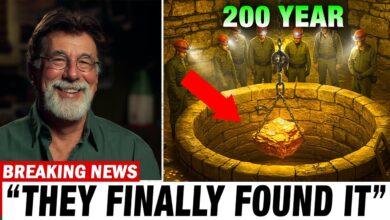The Curse of Oak Island: EXCITING SCAN RESULTS Reveal Iron Spike Secrets (Season 7) | History
The Curse of Oak Island: EXCITING SCAN RESULTS Reveal Iron Spike Secrets (Season 7) | History

[MUSIC PLAYING]
NARRATOR: As a new day begins,
and while the investigation
at the eye of the
swamp continues,
Craig Tester, Alex Lagina, and
Oak Island Historian Charles
Barkhaus have traveled some 50
miles Northeast of Oak Island
to St. Mary’s University
in the city of Halifax.
MAN: Knock, knock.
Hey.
How are you doing?
Good to see you again.
Dr. Brosseau.
NARRATOR: They have arranged
for Dr. Christa Brosseau,
an associate professor
of chemistry,
to scientifically analyze
the possible 18th century
iron spikes that were found in
the uplands earlier this week.
If these spikes can
be dated to a time
before the money pit’s
discovery in 1795,
they could not only
offer important evidence
that the team is close to
locating the main flood
tunnel connected to the
fabled treasure shaft,
they could also
offer evidence of who
built the elaborate money
pit treasure vault and when.
Hi, Xiang.
NARRATOR: Working with her
colleague, Dr. Xiang Yang,
Dr. Brosseau will examine the
spikes using a high powered
scanning electron microscope,
capable of magnifying
objects up to 200,000
times their actual size.
In addition, it can
also help identify
their chemical composition.
We see a bit of
phosphorus here.
I think this is the first
time we’ve seen phosphorus
in an iron object though.
Oh, well.
So it’s typically
called phosphoric iron.
Early methods for
making cast iron
were not very good at
removing phosphorus.
And so you would
see it all the time.
It’s a good indication
that more likely pre-1840s.
That’s really cool.
NARRATOR: Commonly
found in minerals,
such as iron ore, phosphorus
has a great effect
on the durability of metal.
Because high
concentrations of it
will cause iron and steel
to become extremely brittle,
the practice of extracting
it for manufacturing purposes
became common beginning
in the mid-19th century.
We found a lot
of searcher stuff.
This is different, so
maybe this is original.
Yeah.
So right.
More modern
manufacturer of a spike
wouldn’t have used an iron
ore rich in phosphorus.
That’s very interesting.
Yeah, very much so.
Yeah, it’s really interesting.
But this is a second spike.
Basically, the
identical compositions.
OK.
So likely, these two
originated from same batch
of manufacturer.
Right.
That’s good news.
And so that may help you
trace area of manufacture.
Some places in
the world where we
have iron ore rich in
phosphorus includes
Britain and northern Europe.
Oh, wow.
I get excited
every time there’s
a new item, a new science
that can advance our search.
Is it French?
Is it British?
We don’t know for sure.
And we’ve got the
potential to be original.
And that would be huge.
Well, we thank you
for the information.
It’s great news.
And we’re pushing it
back as always old
as it is, but it’s science,
and it’s the truth.
So we’ll pursue that.
Yeah.
It’s a little bit of
more new information.
Yeah.
Thank you.
Thank you again.








